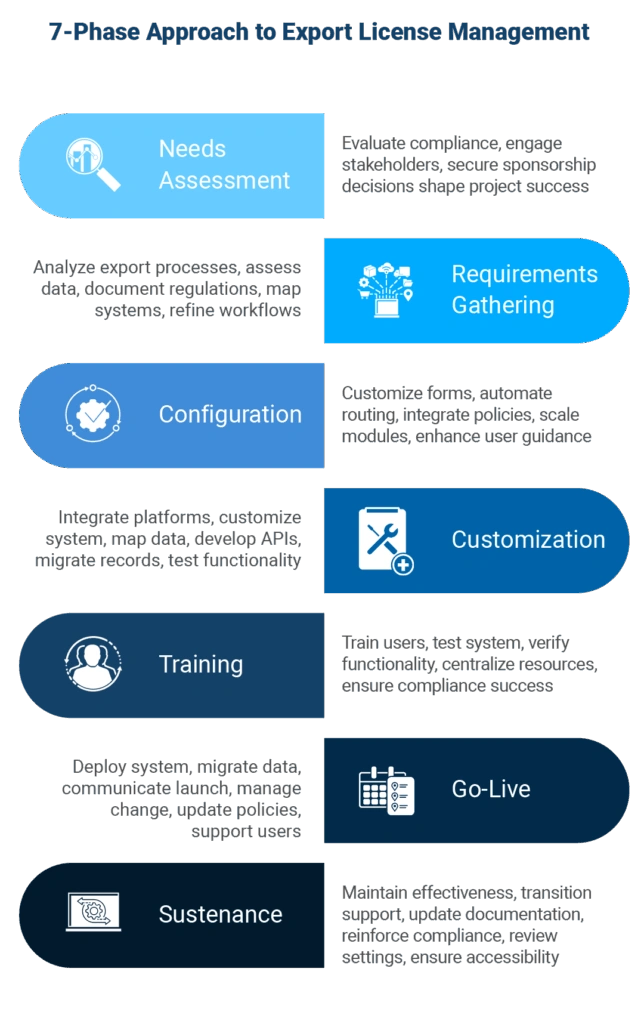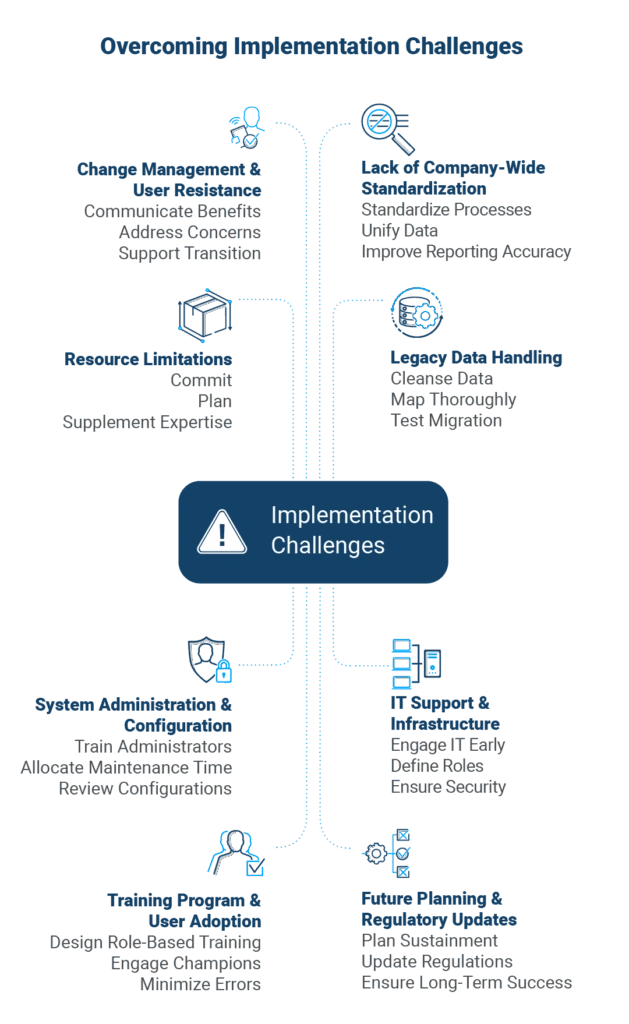In today’s high-stakes trade environment, managing export licenses isn’t just about filling out forms and memorizing tariff codes. With agencies like the Bureau of Industry and Security (BIS) and Office of Foreign Assets Control (OFAC) increasing scrutiny – evidenced by 27 criminal convictions for export-control violations in 2023 calendar year alone – companies can no longer rely on manual processes.. The solution? Integrating advanced export license management software into daily operations, to automate, streamline, and safeguard the business.
Outdated export licensing methods can expose businesses to unnecessary risks, including compliance failures, fines, shipment seizures, and reputational damage that even your best PR team can’t ice-pack away. By implementing export license management software that automates export classification, license application, tracking, and audit readiness, organizations can maintain adherence to complex trade laws while freeing up their export compliance team from bureaucratic complexity.
This guide is your roadmap to successful export license management software implementation. It goes beyond the ‘why’ and dives into the ‘how.’ You’ll learn the key phases, avoid common pitfalls, and gain practical insights from real-world success stories. Whether you’re scaling your compliance program or replacing legacy systems, this guide will help you deploy a solution that turns export compliance into a competitive advantage.
Key Takeaways
- Export license management solutions are essential, not optional. Violations can result in penalties of up to $300,000 per incident or twice the value of the shipment — and may carry criminal sentences of up to 20 years.
- Phased implementation delivers better outcomes. Gradual rollouts allow export compliance and IT teams to resolve inconsistencies and process gaps before full deployment.
- Integrated systems enable true automation. Connecting export license management solutions with ERP, shipping platforms, and broker portals ensures end-to-end export compliance — and prevents the creation of new data silos.
- Proven success across industries. Companies like Elbit and Defense Trade Solutions demonstrate that even large, complex export operations can be successfully managed with the right implementation strategy and compliance technology.
Why an Implementation Strategy Matters
The journey from manual tracking and spreadsheets to an automated, centralized export license management system is transformative. A robust solution not only mitigates compliance risks but can enhance how your business is handling international shipments, improving speed, reducing errors, and enabling global expansion with confidence.
A well-executed implementation strategy ensures that this transformation is seamless and cost effective. Our comprehensive 7-Phase Approach provides a structured, actionable framework that breaks down the implementation process into manageable stages, ensuring a smooth transition and maximizing the value of your investment.

The 7-Phase Approach to Implementing Export License Management Solutions
The Descartes 7-phase implementation framework is built from thousands of successful export license management software projects and is designed to help organizations navigate even the most complex deployments with confidence. Implementation projects are often high-pressure environments—where time, budget, and resources are limited—and teams often overlook critical risks until after it’s too late. This proven framework helps mitigate that by guiding you through each phase with the right questions, tools, and real-world insights. Backed by expert knowledge from the Descartes Export Compliance team, it equips you to deliver a successful implementation that drives long-term compliance and operational value.
Phase 1: Discovery, Needs Assessment, and Business Alignment
This kickoff and alignment phase is the foundation of a successful export license solution implementation. It begins with evaluating the current compliance landscape, identifying delays, errors, and inefficiencies, and aligning key stakeholders. Assembling a core team—including representatives from Trade Compliance, Legal, IT, and Operations—ensures collaboration across critical functions. Clear project goals are established, such as automating export license applications, reducing manual paperwork, improving license tracking, integrating systems, and enhancing audit readiness. Internal champions are identified to drive the initiative forward, while the project’s scope and expected outcomes are precisely defined. Finally, securing necessary resources—including personnel, budget, and technology access—sets the stage for an effective and well-supported implementation.
Phase 2: Requirements Gathering
This phase ensures the final solution is precisely tailored to your organization’s existing workflows, data structures, and export compliance objectives in the following key areas:
I. Mastering Your Data: Integration and Foundation
Determine where essential master data, such as customer/consignee details and product information is stored. Evaluate whether this data is centralized or distributed across multiple systems. Data quality and consistency are also crucial to ensuring seamless transactional record creation within the platform. Additionally, integrating key data elements plays a vital role in system functionality. Customer and consignee data must be incorporated effectively to support accurate party citations in export licenses and shipments, as well as denied party screening processes. Similarly, integrating product master data allows for proper referencing and export classification, which is required for accurate license applications and shipment documentation.
II. Optimizing the Export Licensing Lifecycle: From Request to Management
To configure the solution for specific export license management needs, it is necessary to examine current processes, from the initial request to post-approval management. The export license process begins with identifying the teams or roles that typically initiate export license requests. Gathering essential information from business users is a key step, and configurable questionnaire capabilities can streamline this intake process for the team. The application, review, and submission phase involve mapping internal workflows for reviewing and approving export license applications before they are submitted to government agencies. Once licenses are obtained, post-approval authorization management ensures standardized internal sign-offs, tracks provisos and conditions, and manages license utilization for export activities efficiently.
III. Streamlining Export Operations: System Integration and Transactional Compliance
Streamlining export operations requires seamless system integration and transactional compliance. When implementing export processes to ship against a license, discussions often involve collaboration with IT teams to integrate order screening, determine how to release transaction holds based on approved licenses, and ensure smooth data flow between existing systems and export licensing software. ERP and order processing integration plays a vital role, as it allows sales orders or shipment requests to be brought into the system for necessary compliance checks, such as export license determination and sanctioned party screening. Trade Compliance teams must also learn to manage and release transaction holds by referencing approved export licenses while ensuring all compliance requirements are met. Additionally, data mapping and document generation are essential elements in this process. By working closely with IT teams, organizations can establish clear data mapping between their systems and the export licensing platform while configuring necessary shipping documents directly within the solution. A thorough understanding of these areas helps tailor the export licensing software to operational needs.
Phase 3: Customization and Integration Phase (if needed)
If customizations are identified during the Discovery Phase, the Product Team manages the process by working through requirements signoff and collaborating with R&D to develop the necessary functionality for project execution. Based on the needs identified in the Discovery or Customization Phase, the client’s IT team will then develop integration interfaces using API guides and conduct System Integration Testing (SIT). This phase may involve activities such as transferring legacy master data and testing order integration for Export Operations to ensure seamless functionality within the system.

Image 1: Seven-Phase Approach to Implementing Export License Management Software
Phase 4: System Configuration & Team Training
This phase begins with system configuration, where process owners and future administrators collaborate to translate documented needs into a fully functional solution. The goal is to ensure the platform reflects established business processes, export license management workflows, and critical compliance rules while accommodating the organization’s specific operational methods and export strategies. Once the export license management system is configured, training becomes the primary focus. System administrators receive specialized training to manage settings, user roles, permissions, and ongoing system adaptations post-implementation. Functional users undergo hands-on training built around real-world export management scenarios, helping them navigate customized forms, execute specific tasks, and understand how the system supports their roles within established workflows. By the end of this phase, the export licensing software is fully configured to meet business requirements, and the team is equipped with the knowledge and confidence to use it effectively, paving the way for a successful validation stage.
Phase 5: User Acceptance Testing (UAT) – Validating Your Solution
This is a critical step in validating the software before its official go-live. Following detailed system configuration and comprehensive user training, this process ensures the solution aligns with operational needs and functions as expected in real-world scenarios. During UAT, teams rigorously test predefined business processes, assessing the system’s ability to handle end-to-end export workflows while validating IT integrations with enterprise systems to ensure seamless data exchange. The phase culminates in an Internal Readiness Assessment, where project stakeholders review results, address any logged issues, and determine overall preparedness. Based on this evaluation, the organization makes a go/no-go decision, ensuring that both the export license management system and users are fully equipped for live production. Successfully completing UAT provides the confidence that the tailored software will enhance export compliance operations while meeting business demands effectively from day one.
Phase 6: Go-Live and Hypercare for Export License Management Software
After thorough planning, testing, and training, the go-live phase marks the transition to live operations—where your export license management solution becomes fully active.
Final Cutover: Preparing for Export Compliance in Production
Before go-live, your team executes final cutover tasks to ensure a smooth transition. This includes system readiness checks to ensure it is optimized for export license processing, along with a structured change management rollout that clearly communicates new workflows, policies, and export license procedures across departments.
Go-Live Day: Launching Export License Automation
On go-live day, your export license management software becomes fully operational. Teams begin using the system to classify items, apply for export licenses, and track compliance in real time—all within your production environment.
Hypercare: Stabilizing Export Operations Post-Launch
Following launch, a defined hypercare period provides intensive support to resolve early issues and optimize system performance. Rapid-response assistance helps users adapt to the new environment, while reinforcing confidence in automated export license workflows.
Phase 7: Long-Term Sustainment of the Export License Management System
After the hypercare period, the team shifts to standard support channels for ongoing assistance, expert advice, and issue resolution. Structured processes ensure long-term success, including transitioning inquiries to support, maintaining updated documentation, and reinforcing compliance through periodic reviews. Easy access to SOPs and process maps supports daily operations, while regular system configuration reviews keep the platform aligned with changing business and regulatory needs. Launching your export license management software marks a major milestone—the start of a more efficient, compliant era for export operations, backed by sustained support and continuous improvement.
Top Implementation Hurdles in Export License Management Software—and How to Solve Them
Implementing a new export licensing solution is a significant undertaking and like any technology deployment, challenges can arise. Anticipating and planning for common obstacles is crucial for a successful go-live and realizing the full value of your investment.

Image 2: Key Implementation Issues in Export License Management Software
Here are common pitfalls faced during implementation, their impact and effective ways to mitigate them:
- Resource Limitations
Insufficient project team members (across compliance, IT, operations), budget, or dedicated time causes project delays, compromises implementation quality, and strains the project team.
Mitigation Strategies: Secure clear executive commitment for required resources. Develop a realistic, detailed project plan and assign dedicated personnel time. Supplement internal capacity with vendor or consultant expertise if needed. - Legacy Data Handling
Migrating existing, often inconsistent or incomplete, historical export data leads to errors in system configuration, inaccurate screening results, potential compliance risks, and significant project delays.
Mitigation Strategies: Plan a thorough data cleansing and mapping process upfront. Dedicate a team to data activities. Conduct rigorous testing of data migration before final cutover. - IT Support & Infrastructure
Failing to ensure sufficient and timely involvement from internal IT delays technical setup, causes integration failures, disrupts security processes, slows troubleshooting, and hinders timely system updates after go-live.
Mitigation Strategies: Engage the IT team from project kickoff. Clearly define their roles and responsibilities for both implementation and ongoing support. Ensure adequate IT resources are allocated consistently. - Export Licensing System Administration & Configuration
Without adequately trained internal staff to oversee system maintenance, configuration adjustments, and user management after deployment, the system risks stagnation, performance degradation, and increased reliance on external support for routine tasks.
Mitigation Strategies: Identify and provide in-depth training for internal administrators during the project. Allocate dedicated time for system maintenance and regular configuration reviews to stay aligned with business and regulatory changes. - Training Program & User Adoption
Developing and delivering effective training that ensures all end-users can correctly and confidently use the new system results in low user adoption, increased errors, use of workarounds, higher support requests, and failure to fully realize the system’s benefits.
Mitigation Strategies: Create role-specific training materials and deliver hands-on training. Provide accessible documentation (SOPs, guides). Leverage internal champions to support colleagues. Also look at what training and product knowledge resources your vendor offers. Leading export compliance solutions providers offer regular training to ensure your team get the most out of their software. - Neglecting Future Planning and Regulatory Updates
Not planning for the long-term effort and resources required to maintain the system’s effectiveness and relevance over time. The system can become outdated, compliance gaps may emerge, and the initial investment value diminishes without ongoing care.
Mitigation Strategies: Establish a formal sustainment plan including ongoing budget/resources, regular system reviews, and a process for managing updates and enhancements post-go-live - Change Management & User Resistance
The introduction of new software or modified processes frequently leads to natural user resistance. Users may become confused, make errors, avoid the system, resist the changes, fail to follow correct procedures, and experience frustration. This can decrease initial productivity, limit system effectiveness, and ultimately undermine project success.
Mitigation Strategies: Communicate the reasons for changes and the benefits. Involve users early and address concerns openly. Provide robust training on both systems and new workflows and offer continuous support by documenting new processes. - Lack of Company-Wide Standardization
Inconsistent processes, data formats, or terminology across different parts of the organization make system configuration difficult. Complicated data integration leads to inconsistent compliance practices and hinders accurate reporting.
Mitigation Strategies: Identify standardization needs during discovery. Work to standardize key processes and data formats where possible, either before or as part of the implementation. Involve stakeholders from all affected areas.
By acknowledging these potential challenges and proactively planning mitigation strategies, you can significantly increase the likelihood of a smooth implementation, ensure strong user adoption, and ultimately maximize the value your organization derives from its new export license management solution.
Real-World Impact of the 7-Phase Implementation Strategy: Customer Success Stories
These customer successes showcase organizations that, through a methodical deployment aligned with the 7-Phase Implementation Approach, have leveraged Descartes export compliance solutions to achieve significant transformations in their global trade and export license management:
Defense Trade Solutions Scaled Compliance with a Uniquely Tailored Descartes Export License Management Deployment
When Defense Trade Solutions (DTS), a firm specializing in aerospace and defense trade compliance, outgrew manual processes like spreadsheets and Word documents, they turned to Descartes OCR Global EASETM to scale their operations. DTS took a deliberate approach: working closely with Descartes’ implementation and customer success teams to configure the system not just for internal use, but for the needs of their expanding client base. By properly configuring the system for their unique managed services model, DTS was able to deliver integrated, automated export license management to customers. The result: faster, more accurate export authorization handling, seamless restricted party screening, and improved client satisfaction. This phased, purpose-built implementation empowered DTS to act as a one-stop export compliance department, blending advanced automation with expert advisory. The success highlights how thoughtful, tailored deployment of export license management software can drive scalability, streamline operations, and ensure airtight regulatory compliance—particularly in complex, high-risk sectors like defense.
By partnering with Descartes, DTS successfully transformed its approach to export license management, enabling greater efficiency, scalability, and a higher level of service for its clients in the complex aerospace and defense sector.

Elbit Strengthens Compliance Across the Export Lifecycle with Strategic Implementation of Descartes Solutions
Elbit Systems of America, a leading aerospace and defense firm, strategically implemented Descartes’ OCR Global EASE to strengthen its export compliance across multiple functions—from denied party screening and export license management to shipment documentation and export classification. Given the sensitive nature of its operations, the company required a solution tailored to its complex regulatory environment.
By deploying Descartes OCR Global EASE on-premises and now planning a move to the cloud for improved agility and response times, Elbit has achieved a more scalable, responsive trade compliance program. The implementation was collaborative and problem-solving oriented—leveraging Descartes’ deep experience and evolving security capabilities to support everything from export license decrementing to export transport workflows.
This partnership has not only ensured operational compliance and efficiency but also empowered innovation within Elbit’s compliance team—demonstrating that a trusted, adaptable technology partner can be the catalyst for modernizing trade compliance in the most demanding industries.

Video 1: Shane Hill, Senior Trade Compliance Manager at Elbit Systems, shares how Descartes helps streamline critical export license management tasks.
Best Practices to Keep in Mind
As we’ve explored the phased approach and common challenges, a few key takeaways stand out for ensuring your project’s success and capturing long-term value.
Fundamentally, view your export licensing solution not just as a software purchase, but as a strategic investment in long-term global trade compliance maturity. It’s a move that positions your organization for more reliable, scalable, and visible global trade operations well into the future.
To pave the way for success, start with clarity. Ensure your project goals are well-defined, meticulously document your current and future processes, and critically, involve the right people—from executive sponsors to daily users—from the very beginning. Their input and buy-in are invaluable.
When selecting the technology itself, prioritize a solution that inherently supports scalability to grow with your business, robust automation to streamline manual tasks, and seamless integration capabilities to connect with your existing business systems.
Finally, the launch is not the finish line. The real ROI is captured through diligent sustainment efforts post-go-live. Continuously improve, maintain documentation, provide ongoing training, and regularly review your system’s configuration to ensure it remains aligned with evolving business needs and global trade compliance regulatory landscapes.
By keeping these principles in mind and approaching implementation with a structured plan, your organization can successfully navigate the complexities and unlock the full potential of a modern export licensing solution.
Ready to Transform Your Export Licensing Processes?
Descartes offers comprehensive export license management solutions designed to meet these demands with unparalleled flexibility and powerful functionality. Imagine an integrated platform that simplifies the process of applying for, tracking, and managing your export licenses. Descartes solutions provide this, often including direct integration into U.S. government portals to eliminate manual data entry and ensure you are fully compliant with evolving regulatory requirements.
These solutions are built with modular capabilities, allowing businesses to tailor the platform precisely to their needs. Features include core Export Operations, sophisticated Export License Management for tracking provisos and conditions, Integrated Denied Party Screening to prevent prohibited transactions, and critical Forced Labor Risk Management tools. This modularity ensures you implement the capabilities you need now and can easily scale as your business grows, compliance requirements expand.
Now is the time to take a critical look at your current export licensing operations. Are hidden inefficiencies costing you valuable time and resources? Are manual steps introducing unnecessary risks? Don’t let complexity slow down your exports or erode your profit margins. Request a demo today to experience firsthand how Descartes export licensing solutions can transform your export operations and empower your global trade strategy.




